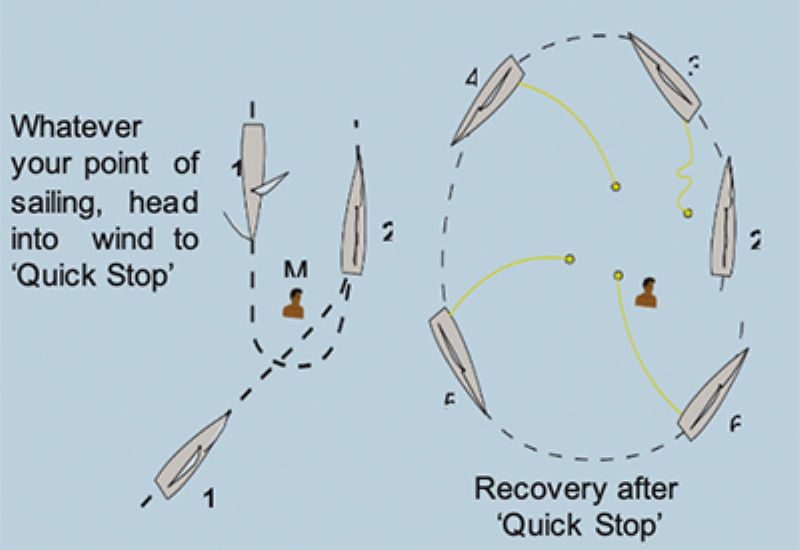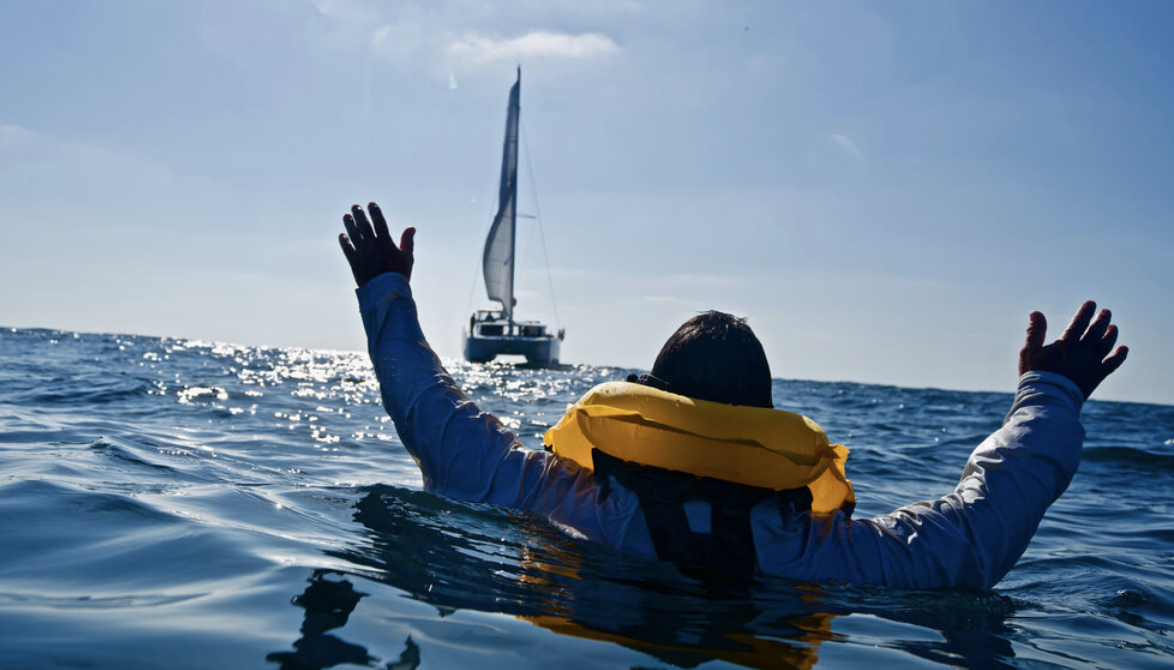Man Overboard Procedures
Figure 1:
Edited by John Gullick, Manager of Government Programs, Canadian Power and Sail Squadrons
Ed. Note: please review this information (even if you think you know it!)
Most of this information is taken from the Canadian Power and Sail Squadrons (CPS-ECP) BOATING 4 – Seamanship course which I have updated and edited.
For more information about this and all the other CPS-ECP courses and seminars go to boatingcourses.ca and look under Courses and Seminars.
Man Overboard
Prevention is the best solution to avert man overboard (MOB) accidents before they happen. Take every precaution to avoid such a situation. A passenger or crew member can tumble overboard at any time and under any conditions. If someone must go on deck, in any but the calmest weather, wear a safety harness attached to a proper jack line or suitable strong point on the boat.
Always wear a PFD that has a highly visible color. At night, the PFD should have a light attached, preferably a strobe, that automatically lights up when immersed in water.
Remember, PFDs (lifejackets) do not work if you are not wearing them, so we advise wearing them at all times while on deck or in an open boat while underway.
Rescue Drill, the Quick Stop Method
Remember this sequence:
Shout – Throw – Stop – Lookout – Return
Shout
Cry “Overboard” to alert all on board that someone is in the water.
Throw
Immediately throw the nearest available floating object toward the victim in the water, followed by a proper life ring and/or man-overboard pole.
Stop
Immediately, stop the boat.
Lookout
The lookout is the invisible lifeline between the victim and the boat. One of the crew must point constantly at the victim in the water to guide the helmsman. High waves can obscure the victim and make this essential task very difficult.
Return
Return to the victim’s position as rapidly as possible. When the victim is close abeam, make sure the propellers are completely stopped. It cannot be too strongly emphasized that moving propellers will inflict grave damage to a body.
This procedure can be carried out efficiently only after plenty of practice. Both the approach to the victim and bringing the victim aboard should be practiced until the crew is comfortable with all steps of the procedure.
Rescue of the Overboard Victim
Rescue of a person overboard involves three stages:
- bringing the victim alongside the boat;
- bringing the victim on board;
- caring for the victim.
Be prepared for any factors that may complicate the rescue. Sudden immersion in cold water can have serious effects. The initial gasp reflex may cause a significant amount of water to be swallowed or inhaled and can lead to near drowning. Even if the victim is wearing a PFD, near drowning can arise from water washing over the head.
Typically, there is a loss of manual dexterity and strength, even after a relatively short time in the water. Cold water effects can begin to occur within as little as 15 minutes, depending on the temperature of the water.
Be prepared for near drowning effects and the possibility that victims may be unable to swim or assist themselves. Data from the United Kingdom shows that 55% of open water immersion deaths occur within 3 metres (10 ft) of safety, 42% within 2 metres (7 ft) of a vessel. The victim may be unable to swim these short distances even when his life may depend on it. Quick recovery is essential; practice will speed up the recovery time.
Each incident demands its own specific actions but the most important is to immediately secure a line to both the victim and your boat. There are no hard and fast rules as to whether the victim should be to windward or leeward. If on the windward side, high seas could smash the victim against the hull. There may be more shelter to leeward and the boat will not drift away. The decision is the skipper’s.
Making a Rescue Maneuver
Stay near the man overboard and get back quickly under power or sail. To use the ‘quick stop’ method under sail, (Figure 1), turn the boat into the wind, and then circle the MOB slowly. Drag the ring buoy or Lifeslingline (if you have one) or other line into the victim’s hands.
Alternatively throw a line when the boat stops. If under sail, trim the sails tight and don’t cast off the jib sheet when tacking or jibing. The mainsheet keeps the boom from banging around, and the backed jib slows the boat and allows quick turns.
Under Power:
Use the ‘Williamson Turn’. Upon hearing the MOB call, note the vessel’s heading. Put the rudder over hard in the same direction as the MOB. When clear of the victim, go full ahead with the rudder hard over until you have turned about 60°. Turn the rudder full over in the opposite direction until you are heading back towards the MOB. Several metres from the MOB, take the engine out of gear and throw a line, or lower a Lifesling, to the victim.
Note: In a MOB situation it is essential that the helm be turned in the same direction as the MOB. This turns the stern and the propellers away from the victim. As an example: a vessel doing 10 knots covers 5 m (16 ft) per second, so someone falling overboard from amidships on a 9 m (30’) boat will be astern of the propellers within one second.
Under Sail:
- Use the ‘figure eight’ maneuver (Figure 3), which involves a couple of This method is useful in strong winds because there is no jibe involved. Immediately get on a beam reach and sail for a few seconds. Then tack and reach back downwind of the MOB. Then head up to the victim trailing the Lifesling or throwing a line. As you approach the victim, either luff your sails and approach at the mini- mum speed to maintain steerage, or heave to.
- If you heave to after returning to the MOB, the boat will be moving along very slowly and, in most cases, self-steering so nobody is needed at the helm. To do this on a close reach, trim the jib flat on the wind- ward side and adjust the mainsheet and traveler so the boat self-steers. In a variation called the ‘Rod stop’, sail on a beam reach, roll up or luff the jib and push the mainsail all the way out and secure it there.
Figure 3:
Recovery of Victim Back Onboard
In most cases, the victim will be very heavy due to wet clothing and will be incapable of helping. In addition the victim may have been injured in the fall. The proc dure to get the victim back on board depends on the size of the boat, the available equipment and the number of crewmembers. Skippers must know the best procedure for their own boat and practice it, long before the need arises. There are no hard and fast rules that apply to every boat.
In general, it is hazardous to bring a victim over the stern when any kind of sea is running. It is better to bring them over the side. Studies conducted by the Royal Navy suggest that victims recovered in a horizontal position, (as illustrated in Figure 4), are less likely to collapse than victims who are upright when pulled from the water. A line made up with a bowline on a bight, or Spanish bowline should be prepared and at hand to assist in getting the victim on board.
Figure 4:
If the boat has less than two feet of freeboard, the quickest way to get a victim back on board is to have one or two crew members take hold of an arm and shoulder on each side of the victim and then hoist the person on board. The victim must always be facing you. Do not lift a person facing away from you, as you may cause injury to the back.
If the victim is injured, weakened or unconscious launch your life raft or dinghy, attached to your vessel by a long line. Then the rescue can be done via the smaller craft. Under no circumstances should you enter the water. If the boat is equipped with a transom platform or a swim grid the problem of high freeboard is lessened. A half-inflated rubber dinghy can aid in the recovery of the victim.
Care of the Rescued Victim
Gently lie the victim down. If the victim is conscious, remove wet clothing, wrap in a blanket or sleeping bag, and body heat will gradually warm the victim. Lying next to the victim to add your own body heat may also help. If you have been trained, and the victim is not breathing but has a heartbeat, begin rescue breathing. If the victim is unconscious, not breathing, and has no heartbeat begin CPR. Both these procedures must be continued until the victim is breathing and has a heartbeat once again. Give warm drinks once the victim is conscious. Avoid caffeine or alcohol.



